Blog
TMS Buying Guide | Part 3- Transportation Management System Functions and Features: What to Start With

Transportation Management System Functions and Features: What to Start With
When purchasing a new TMS, it can be easy to lose sight of your business goals and the top priorities for your new solution.
Buyers often underestimate how easy it is to over-buy technology, experiencing “bright, shiny object” syndrome. They have a mindset for growth and want a solution that will serve them well through that growth. This mindset is inherently good, but buyers must be careful to avoid making the wrong decision for today’s needs.
Choosing a TMS for growth
Freight brokers and 3PLs must weigh the various options of functionality and features that they need from their transportation management systems (TMS), for their business goals now and into the future. To successfully implement a solution at any stage of growth, and get employee and customer adoption, it’s important to strategically choose the best foundation to build upon.
Some TMSs have one main selling point—they can do A or B but not C, D, or E. If the broker’s business in the future requires the ability to do C, D, or E, their TMS choice now needs to reflect this. It’s imperative to have a TMS that allows for growth in the direction the business is heading. At the same time, it’s unlikely that all of those features are needed today so it’s important to have the ability, not obligation, to add them.
The TMS must align with the business’ future
As a broker expands its reach or adds more lines of business, the TMS should be able to adapt. Finding the right TMS means having not only essential functionality but also the ability to add to, modify, or build on as the business changes, no matter the size or maturity of the business or how big or small the deployment.
The TMS must offer flexible configurations and the ability to scale easily. This accommodates any evolution of the business.
With the likelihood that one or more changes will be needed in the future, the TMS should have an intuitive design and ease of operation. This ensures frictionless, fast adoption by employees and customers. It should be a hassle-free process to add on tools in the future, which prevents the business from being stuck paying right out of the gate for features they’ll need in the future, before they’re necessary.
How to assess TMS features for growth-stage and established brokers
Growth-stage brokers
Early-growth brokers with a small book of business should look to optimize operations and have the tools they need to grow. These brokers should prioritize the following features:
Complete quote-to-cash brokerage workflows – By having everything located in a single system, workflows can be optimized and standardized. There is no needless clicking back and forth to different systems and wasting time re-entering the same information.
Carrier onboarding – The onboarding process should be digital and designed for easy adoption. It provides a better experience for the carrier and simplifies internal processing for the brokerage.
Basic integrations (such as load boards) – The capability of connecting directly with the most important tools is a necessity, serving as a foundation to build workflow efficiency and future automation.
The goal for growth-stage brokers is to get foundational features along with additional flexibility for the future—to avoid over-buying features now while setting themselves up with a TMS to build onto, rather than one they have to grow into.
Established brokers
Established freight brokers are already using a TMS but are looking for something more robust to remove bottlenecks holding the business back. These brokers should consider the following features:
Integrations with commonly used tools (such as additional load boards and visibility tools) – More integrations are likely needed for an established broker. There are more moving parts to work with, and each piece should be set up for minimizing friction in user workflows.
Functionality for types of freight beyond TL – Brokerages should have the ability to expand to include basic and advanced LTL capabilities. LTL optimization requires complex algorithms to bring a high-value service to the customer.
Workflow automations – This increases efficiency and allows for scalability. The simple and repetitive tasks are covered by automation, and employees can be more productive at value-adding activities.
Customer/carrier self-service portals – Offering better connectivity for customers is an opportunity to improve customer service and strengthen loyalty. It also benefits employees with the potential to increase productivity.
The goal of established brokers can be summed up by focusing on a more optimized system, through integrations and automations, that better serves them and their customers.
Simplifying operations for growth
Healthy brokerages are businesses that adapt and evolve and don’t remain stagnant. Technology changes, and business needs change. TMSs today are able to meet where the brokerage is currently at, through varying stages of growth. Brokers can choose the TMS features and functionality to simplify operations and set them up for the future, without an over-commitment in the present. The result is freeing up resources to help to unlock the brokerage’s full potential.
3G brings flexible solutions no matter where the brokerage is at in its growth. Schedule a demo to see 3G’s TMS in action and find the right fit for your business.







